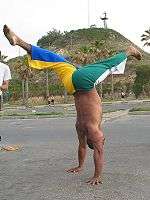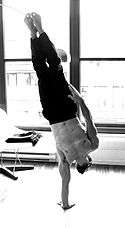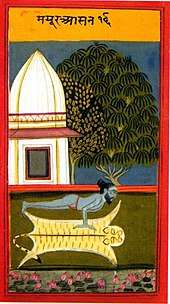Handstand
A handstand is the act of supporting the body in a stable, inverted vertical position by balancing on the hands. In a basic handstand the body is held straight with arms and legs fully extended, with hands spaced approximately shoulder-width apart and the legs together. There are many variations of handstands, all of which require the performer to possess adequate balance and upper body strength.

Handstands are performed in many athletic activities, including acro dance, cheerleading, circus, yoga, calisthenics, and gymnastics. Some variation of a handstand is performed on every gymnastic apparatus, and many tumbling skills pass through a handstand position during their execution. Breakdancers incorporate handstands in freezes and kicks. Armstand dives—a category found in competitive platform diving—are dives that begin with a handstand. Swimmers perform underwater handstands as a game, with their heads, arms, and bodies underwater with their legs and feet extended above the surface, often having contests with the winner being the person who can remain in an underwater handstand the longest.
Handstands are known by various other names. In modern yoga as exercise, the handstand is called Adho Mukha Vrksasana. In capoeira it is named bananeira.
Yoga
In modern yoga as exercise, the handstand is among the inverted poses; it is known as Adho Mukha Vrksasana,[1] Downward-facing Tree Pose. In traditional hatha yoga in the 18th and 19th centuries, the Vyayāmadipike, which calls it the "second gardam", and the Śrītattvanidhi use the handstand in a sequence involving touching the nose to the ground; the Haṭhābhyāsapaddhati calls this Syenasana, meaning hawk pose.[2]
Gymnastics
There are two basic handstand styles in modern gymnastics: curved-back and straight-back.[3] Straight-back style is employed when the aesthetics of straight body lines are desired and feasible. In many cases (e.g., when a handstand is being performed in conjunction with a gymnastic apparatus), however, the curved-back style is preferred as it offers superior control of the legs and torso over balance. In all cases, balance is maintained by shifting body weight towards the fingers or the heel of the hand.
All basic gymnastic handstands have these characteristics:
- Straight arms with hands placed on the ground approximately shoulder-width apart.
- Straight legs, held together.
- Pointed toes so as to continue the lines of the legs.
In addition, straight-back handstands have these characteristics:
- Tucked head (face pointed forward) as if standing upright.
- Straight spine, with hips pushed forward. If performed while lying flat, this would cause the small of the back to contact ground.
Breakdance
Handstand "freezes" are common in breakdance, in which dancers strive to assume visually interesting body shapes that are not subject to formal rules.
Variations
Common handstand variations include:
- Straight legs held in a side or front split.
- Stag split, in which legs are front split with bent knees.
- Back extremely arched, with bent knees and toes touching the back of the head.
- Hollowback, with hyperextension of the back so that legs are held further back than the head.
- One-handed, in which only one hand contacts the ground.
- Handstand pushups, in which one raises and lowers the body while standing inverted on the hands.
- Straddle split handstand
 A capoeirista performs a handstand with bent legs |
 Handstand with front-split legs |
 One-armed handstand with straddle split |
 One-armed handstand with legs together |
 Yoga pose: Adho Mukha Vrikshasana (handstand) with legs in Garudasana (Eagle pose) |
See also
| Wikimedia Commons has media related to Handstand. |
- Hand balancing
- Hand walking
- Head stand
- List of asanas
References
- Budilovsky, Joan; Adamson, Eve (2000). The complete idiot's guide to yoga (2 ed.). Penguin. p. 179. ISBN 978-0-02-863970-3.
- Birch, Jason; Singleton, Mark (2019). "The Yoga of the Haṭhābhyāsapaddhati: Hathayoga on the Cusp of Modernity" (PDF). Journal of Yoga Studies. 2: 3–70. doi:10.34000/JoYS.2019.V2.
- "Different Styles of Handstands". Retrieved 2010-09-29.
_from_Jogapradipika_1830_(detail).jpg)

